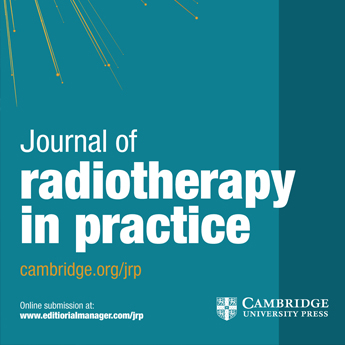Latest Research Publications from the UF Health Proton Therapy Institute
Each research study published is one step forward to better understanding cancer and the effectiveness of cancer treatment options. Below are the latest publications by our physicians either as primary investigators or co-authors with oncology experts from around the world.
Read our full research portfolio here.

Prostate Cancer
Article Title:
Method for determining a Prostate Cancer LET Sensitivity Index (PCLSI) using tumour-specific DDR mutations for proton RBE Feb 2025
Authors:
The UF Health Proton Therapy Institute Medical Physics team - Michael J. Vieceli, PhD, Jiyeon Park,PhD, Mohammad Saki, DSc, PhD, Yawei Zhang, PhD, Hardev S. Grewal, PhD, Perry B. Johnson, PhD, and Nancy P. Mendenhall, MD, FACR, FASTRO
Why this is important:
Developing methods to improve the personalization of treatments for each patient is critical to improving outcomes for patients. The medical physics team continues to research to understand how linear energy transfer of protons can predict the biological effectiveness of treatments.
Article Title:
Predictive Model of Acute Rectal Toxicity in Prostate Cancer Treated With Radiotherapy Mar 2025
Authors:
Nancy P. Mendenhall, MD, FACR, FASTRO, et al.
Why this is important:
This research developed a method to predict the rectal side effects for patients with prostate cancer treated with both proton therapy and photon radiation. The goal is to use this data to personalize treatment options for each patient with prostate cancer.
Head and Neck Cancer
Article Title:
P16/HPV-negative oropharyngeal squamous cell carcinoma survival: Comparing primary surgery to primary chemoradiotherapy. A systematic review and meta-analysis Mar 2025
Authors:
William Mendenhall, MD, FACR, et al.
Why this is important:
Oropharyngeal squamous cell carcinoma (OPSCC) is a type of head and neck cancer. This study analyzed data from research on HPV-negative OPSCC, which often have lower cure rates than HPV-positive cancers. Patients with early-stage cancers had improved survival rates with surgery as their main treatment. Advanced cancers showed improved survival rates with both chemo and radiation as their primary treatment.
Article Title:
The Oncological Outcome of Postoperative Radiotherapy in Patients with Node-Negative Early-Stage (T1/T2/N0) Oral Squamous Cell Carcinoma and Perineural Invasion: A Meta-Analysis Mar 2025
Authors:
William Mendenhall, MD, FACR, et al.
Why this is important:
This study specifically looks at patients with oral cancer that has not yet spread to the lymph nodes. Patients who received radiation therapy after surgery were found to have improved survival rates and fewer cases of cancer recurrence.
Pediatric Cancer
Article Title:
Outcomes following radiation therapy for embryonal tumor with multilayered rosettes (ETMR): results from the Pediatric Proton/Photon Consortium Registry (PPCR) May 2025
Authors:
Daniel Indelicato, MD, et al.
Why this is important:
Even the rarest tumors are worthy of researching as seen in this publication. Embryonal tumor with multilayered rosettes (ETMR) is a rare central nervous system tumor found in infants that has a survival rate of only approximately 25%. This study showed that proton radiation included in a treatment plan resulted in promising survival rates for these young patients.
Article Title:
Twenty Years of the Pediatric Radiation Oncology Society May 2025
Authors:
Daniel Indelicato, MD, et al.
Why this is important:
The Pediatric Radiation Oncology Society (PROS) was established in 2005 to promote and educate others about radiotherapy for young patients worldwide, with a focus on improving care in underprivileged areas. PROS hosts congresses and works with the International Society of Pediatric Oncology to advocate for better radiation oncology care for children and young adults. This publication outlines the mission and future vision of PROS, which includes continued collaboration in improving outcomes for children with cancer.
Article Title:
Nonorbital, Nonparameningeal Head and Neck Rhabdomyosarcoma: A Report From the Children's Oncology Group Mar 2025
Authors: Daniel Indelicato, MD, et al.
Why this is important:
Researching rare subsets of otherwise common cancers is critical to determining ways to improve patient care and treatments. Analyzing data for a rare cancer, nonorbital, nonparameningeal head and neck (NONPHN) rhabdomyosarcoma, researchers determined that performing sentinel lymph node sampling in certain patients was not necessary. This will help reduce unnecessary procedures and treatments for future patients.
Improving Cancer Treatment for Patients
Article Title:
Operational Improvement of a Proton Therapy System From Reduced Energy Layer Switching Time June 2025
Authors:
UF Health Proton Therapy Institute Medical Physics team – Hardev S. Grewal, PhD, Yawei Zhang, PhD, Perry B. Johnson, PhD, Mohammad Saki, DSc, PhD, Jiyeon Park, PhD
Why this is important:
The medical physics team was able to reduce the proton treatment delivery time for patients by decreasing the time it takes to switch the proton beam from one layer to another with pencil beam scanning. The average length of treatment delivery was reduced by over 50% with the biggest difference in treatment times seen with 59.5% reduction for head and neck cancer patients.
Article Title:
Independent Review Organization and Proton Therapy: Multistate Analysis and Legal Procedural Strategies
Authors:
Nancy P Mendenhall, MD, FACR, FASTRO, et al.
Why this is important:
In order to increase the ability for patients to access proton therapy when appropriate, this research analyzed the use of independent review organizations (IROs) in the insurance denial process. The authors concluded that properly using the independent review process may lead to more patients accessing proton therapy.
